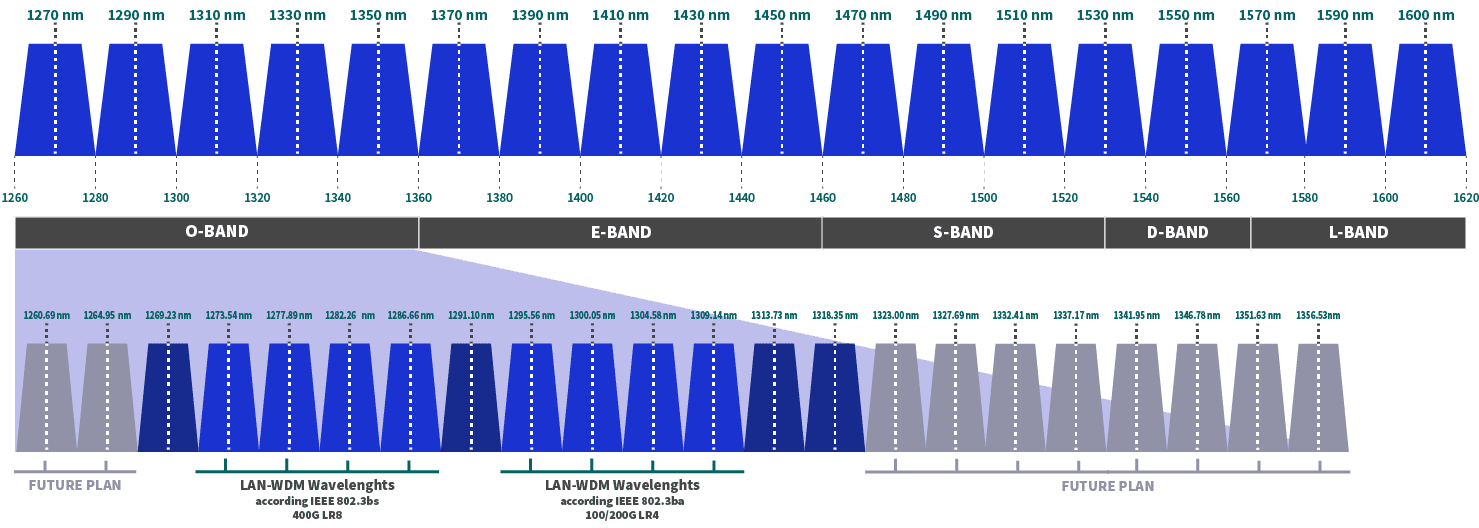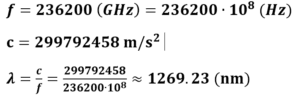
LWDM Channel Plan
LWDM channel plan – 800 GHz O-BAND LWDM channels overview, wavelengths, list of channels and xWDM systems in this support article.
LWDM (Local Area Network Wavelength Division Multiplexing) is one of the newest xWDM technologies and use in 100G, 200G, 400G optical links that has been adapted for use in 25G SFP28 transceivers. This innovation provides greater flexibility in network design and enables 5G implementation using available 100G and 200G LAN-WDM transceivers by utilizing LAN WDM wavelengths. LWDM ITU-T standardization is under way should be available by 2021.
A quick re-cap of bands and defined wavelength can be found below and in DWDM Channel Plan:
- Original O-Band 1260-1360 nm
- Extended E-Band 1360-1460 nm
- Short Wavelength S-Band 1460-1530 nm
- Conventional C-Band 1530-1565 nm
- Long Wavelength L-Band 1565-1625 nm
- Ultralong Wavelength U-Band 1625-1675 nm
Currently, LWDM systems are based for O-Band with 800 GHz spectral grid with 12 Channels total. Inter-Channel spacing deviates from channel to channel and is in range from 4.26 nm to 4.62 nm (detailed channel list in LWDM 800GHz O-Band Channels table). Additional information regarding transceiver functionality and applications can be found on LWDM eCPRI page.
For ease of com presence below is an image that depicts CWDM Channels (at the top of image) and LWDM channels (at the bottom of image). From it is visible that LWDM channel spacing is much more narrow that CWDM’s (More on CWDM at CWDM Channel Plan). Some LWDM channels do overlap with CWDM’s. Benefits are reduced dispersion and less power required for signal transmission.
Although, clear nomenclature for LWDM Channel’s is not defined it is preferred to use channel’s center wavelength to differentiate between channels.
By using center wavelength (λ) to calculate frequency (f) and vice versa.
For example: Channel 269 with center wavelength of 1269.23 nm and frequency of 236200 (GHz). If you know one, other can be calculated as below:
For calculations speed of light in vacuum constant c=299792458 m/s2 is used:
In LWDM 800GHz O-Band Channels table is the list of all possible O-Band Channels from which 12 are used for communication and those are from Channel 269 to 318 included.
LWDM Channel Plan for 800GHz O-Band Systems:
| LWDM 800GHz O-Band Channels | Channel | Wavelength | Frequency |
|---|---|---|
| # | nm | GHz |
| 260 | 1260.69 | 237800 |
| 264 | 1264.95 | 237000 |
| 269 | 1269.23 | 236200 |
| 273 | 1273.54 | 235400 |
| 277 | 1277.89 | 234600 |
| 282 | 1282.26 | 233800 |
| 286 | 1286.66 | 233000 |
| 291 | 1291.10 | 232200 |
| 295 | 1295.56 | 231400 |
| 300 | 1300.05 | 230600 |
| 304 | 1304.58 | 229800 |
| 309 | 1309.14 | 229000 |
| 313 | 1313.73 | 228200 |
| 318 | 1318.35 | 227400 |
| 323 | 1323.00 | 226600 |
| 327 | 1327.69 | 225800 |
| 332 | 1332.41 | 225000 |
| 337 | 1337.17 | 224200 |
| 341 | 1341.95 | 223400 |
| 346 | 1346.78 | 222600 |
| 351 | 1351.63 | 221800 |
| 356 | 1356.53 | 221000 |
LWDM can be used either with or without MUX and DEMUX units for operational uses. More on LWDM MUX/DEMUX units will be available soon.
For the time being, a Great introduction to MUX/DEMUX systems can be found at both CWDM Channel Plan support article and DWDM Channel Plan support article as these xWDM solutions also require a MUX and a DEMUX unit for operation. More detailed information regarding MUX/DEMUX units is at PASSIVE XWDM section.



